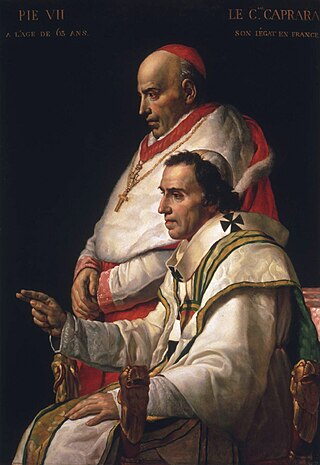
Pope Leo XII, born Annibale Francesco Clemente Melchiorre Girolamo Nicola della Genga, was head of the Catholic Church and ruler of the Papal States from 28 September 1823 to his death in February 1829.

Pope Pius VII was head of the Catholic Church and ruler of the Papal States from 14 March 1800 to his death in August 1823. Chiaramonti was also a monk of the Order of Saint Benedict in addition to being a well-known theologian and bishop.

Pope Pius VIII was head of the Catholic Church and ruler of the Papal States from 31 March 1829 to his death in November 1830.
Papabile is an unofficial Italian term first coined by Vaticanologists and now used internationally in many languages to describe a Catholic man, in practice always a cardinal, who is thought a likely or possible candidate to be elected pope.

Between the Congress of Vienna (1815) and the capture of Rome (1870), the Papal State was subdivided geographically into 17 apostolic delegations for administrative purposes. These were instituted by Pope Pius VII in a motu proprio of 6 July 1816: "Quando per ammirabile disposizione".

In the papal conclave held from 14 to 16 June 1846, Giovanni Maria Mastai Ferretti, Bishop of Imola, was elected on the fourth ballot to succeed the recently deceased Gregory XVI as pope. He took the name Pius IX. Of the 62 members of the College of Cardinals, 52 assembled in the Quirinal Palace, one of the papal palaces in Rome and the seat of two earlier 19th century conclaves. The conclave was the last to elect a ruler of the Papal States, the extensive lands around Rome and Northern Italy which the Catholic Church governed until 1870.

The papal conclave that followed the death of Pius VI on 29 August 1799 lasted from 30 November 1799 to 14 March 1800 and led to the selection of Cardinal Barnaba Chiaramonti, who took the name Pius VII. This conclave was held in Venice and was the last to take place outside Rome. This period was marked by uncertainty for the papacy and the Roman Catholic Church following the invasion of the Papal States and abduction of Pius VI under the French Directory.

Rafael Merry del Val y Zulueta, was a Spanish Catholic bishop, Vatican official, and cardinal.

The papal conclave held from 24 February to 31 March 1829 to elect a successor to the recently deceased Leo XII resulted in the accession of Cardinal Francesco Castiglioni, who took the name Pius VIII.

The mayor of Rome is an elected politician who, along with the Rome City Council of 48 members, is accountable for the strategic government of Rome. As Rome is a comune speciale since 2009, the office is different from the offices of the other Italian cities. The title is the equivalent of Lord Mayor in the meaning of an actual executive leader.

Carlo Odescalchi, was an Italian prince and priest, Archbishop of Ferrara, cardinal of the Catholic Church and Vicar General of the Diocese of Rome. For years a close collaborator of popes Pius VII and Gregory XVI, in 1838 he renounced his titles in order to become a Jesuit.

Giulio Maria della Somaglia ) was an Italian cardinal. and Secretary of State under Pope Leo XII. He was known as a staunch zelante cardinal who helped enforce an authoritarian regime in the crumbling Papal States.

A cardinal-nephew was a cardinal elevated by a pope who was that cardinal's relative. The practice of creating cardinal-nephews originated in the Middle Ages, and reached its apex during the 16th and 17th centuries. The last cardinal-nephew was named in 1689 and the practice was abolished in 1692. The word nepotism originally referred specifically to this practice, when it appeared in the English language about 1669. From the middle of the Avignon Papacy (1309–1377) until Pope Innocent XII's anti-nepotism bull, Romanum decet pontificem (1692), a pope without a cardinal-nephew was the exception to the rule. Every Renaissance pope who created cardinals appointed a relative to the College of Cardinals, and the nephew was the most common choice, although one of Alexander VI's creations was his own son.

The 1721 papal conclave, convoked after the death of Pope Clement XI, elected Cardinal Michelangelo de' Conti, who took the name of Innocent XIII.

Gabriele della Genga Sermattei was a Catholic Cardinal and Camerlengo of the Sacred College of Cardinals.

The 1730 papal conclave elected Pope Clement XII as the successor to Pope Benedict XIII.

Pope Pius VII created 99 cardinals in 19 consistories.

The Sanctuary of Santa Maria infra Saxa and the so-called Tempio di Valadier are two sanctuaries and chapel located at the entrance of the Frasassi Caves, a remarkable karst cave system in the municipality of Genga, in the province of Ancona, Marche, Italy.

Caterina Sordini was an Italian Roman Catholic professed religious that established the Sisters of Perpetual Adoration, in latin Adoratrices Perpetuae Sanctissimi Sacramenti, devoted to the Eucharist. She assumed the religious name of "Maria Maddalena of the Incarnation" when she became a member of the Third Order of Saint Francis during her adolescence.

Francesco Bertazzoli was an Italian prelate of the Catholic Church who was a longtime confidant of Pope Pius VII, who made him a cardinal in 1823.



















